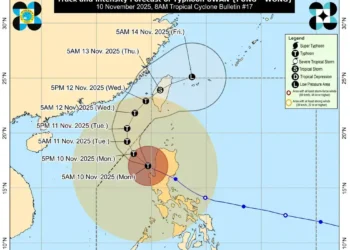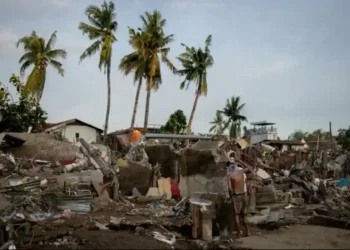MANILA, Philippines — Typhoon Fung-Wong left the Philippines on Monday after battering the northern region with torrential rain and powerful winds that triggered floods, landslides, and power outages. The storm killed at least two people and displaced more than 1.4 million residents, officials said.
The typhoon, locally known as Uwan, made landfall in Aurora province late Sunday as a super typhoon, packing sustained winds of up to 185 kilometers (115 miles) per hour and gusts reaching 230 kph (143 mph). After crossing northern Luzon, it weakened and moved toward the South China Sea, heading northwest in the direction of Taiwan, according to the Philippine state weather bureau.
Nation Still Recovering from Deadly Typhoon Kalmaegi
Fung-Wong’s arrival came as the Philippines was still reeling from Typhoon Kalmaegi, which devastated central provinces last week, leaving at least 224 people dead before moving on to Vietnam, where it claimed five more lives.
Philippine President Ferdinand Marcos Jr. declared a state of emergency on Thursday, citing the severe damage from Kalmaegi and the anticipated impact of Fung-Wong. The back-to-back storms underscored the country’s vulnerability to extreme weather events intensified by climate change.
Widespread Flooding and Evacuations
Authorities said more than 1.4 million people sought shelter in evacuation centers or with relatives before Fung-Wong made landfall. As of Monday, about 318,000 evacuees remained in temporary shelters.
The storm flooded at least 132 villages in northern Luzon, with some residents forced to climb onto rooftops as waters rose rapidly. More than 1,000 houses were damaged, and several major roads were blocked by landslides, said Bernardo Rafaelito Alejandro IV of the Office of Civil Defense (OCD).
In the eastern province of Catanduanes, a man drowned in flash floods, while in Catbalogan City in Eastern Samar, a woman was killed when her house collapsed during the storm.
“While the typhoon has passed, its rains still pose a danger in certain areas in northern Luzon, including parts of Metro Manila,” Alejandro said. “Rescue, relief, and disaster-response operations are ongoing.”
Transport and Power Disruptions Across the Country
Authorities canceled over 325 domestic and 61 international flights through Monday, while ferry services were suspended nationwide due to rough seas, leaving more than 6,600 passengers and cargo workers stranded in ports. Power outages were reported in several provinces across northern and eastern Luzon.
Schools and most government offices were closed on Monday and Tuesday as cleanup and relief efforts continued. Officials said road-clearing operations in landslide-hit areas were expected to accelerate as weather conditions improved.
International Partners Ready to Assist
Although the Philippine government has not yet requested international assistance, Defense Secretary Gilberto Teodoro Jr. said the country’s long-time allies, including the United States and Japan, have expressed readiness to help with relief and rehabilitation if needed.
The Philippine Atmospheric, Geophysical and Astronomical Services Administration (PAGASA) reminded the public that storms with sustained winds exceeding 185 kph are classified as super typhoons, signaling the highest alert level and the potential for catastrophic damage.
A Disaster-Prone Nation Facing Climate Challenges
The Philippines, an archipelago of more than 7,000 islands, is among the world’s most disaster-prone countries, struck by an average of 20 typhoons and storms annually. Its geographic position along the Pacific “Ring of Fire” also makes it vulnerable to earthquakes and volcanic eruptions.
Climate scientists have long warned that warmer ocean temperatures are likely to intensify tropical cyclones in the region, increasing both their frequency and destructiveness. The devastation from Kalmaegi and Fung-Wong, experts say, underscores the urgent need for improved infrastructure resilience, early warning systems, and community preparedness.
As recovery efforts begin, officials continue to assess the full extent of damage to infrastructure, agriculture, and livelihoods across northern Luzon.
This article was rewritten by JournosNews.com based on verified reporting from trusted sources. The content has been independently reviewed, fact-checked, and edited for accuracy, tone, and global readability in accordance with Google News standards.
Stay informed with JournosNews.com — your trusted source for verified global reporting and in-depth analysis. Follow us on Google News, BlueSky, and X for real-time updates.
JournosNews.com follows Google News content standards with original reporting, verified sources, and global accessibility. Articles are fact-checked and edited for accuracy and neutrality.














